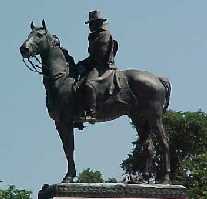| Search Quadrant: |
| Northwest DC |
| Northeast DC |
| Southwest DC |
| Southeast DC |
| Search by Subject: |
| Subjects A - F |
| Subjects G - L |
| Subjects M - R |
| Subjects S - Z |
| Search by Sculptor: |
| Sculptors A - F |
| Sculptors G - L |
| Sculptors M - R |
| Sculptors S - Z |
| Site Credits |
| ThatMan Home |
| KittyTours Home |
 Subject: Ulysses S. Grant
Subject: Ulysses S. GrantYear: 1922
Sculptor: Henry Shrady
Location: Capitol Hill
( West Mall & 1st )
Ulysses S. Grant (1822-1886) was a superlative Civil War general and a mediocre 18th president. His most notable contribution to American politics may have been the word "lobbyist". It is said Grant used to escape from the White House and visit the Willard Hotel, at which he would smoke cigars and drink whisky. People seeking jobs, contracts, and particular positions in legislation would approach Grant in the lobby of the Willard. Grant is said to have referred to them as "those damned lobbyists".
The statue group took over 20 years to complete and was dedicated five weeks before the memorial to Grant's commander-in-chief, Abraham Lincoln. At 252 feet long and 70 feet wide, it is the largest statuary group in Washington. Grant is flanked by Union artillery and cavalry (as well as a few lions) and is often described as contemplating the Union troops camped on the Mall during the Civil War.
General Grant seems pensive and unaffected by the battle raging around him. It is said that he would remain calm during battle and would sometimes sit and whittle while watching the fighting going on.
Shrady was an unknown artist when he received the commission and spent 22 years working on it. Shrady did an immense amount of research in designing the statue group. The secretary of war authorized the loan of Civil War uniforms to him and a number of military posts, including West Point, conducted special drills for his observation and study. The cavalry and artillery groups that flank Grant's statue are particularly impressive. The statue of the lead horse, which Shrady modelled nine times before he was satisfied, has Shrady's thumbprints preserved in bronze.
This memorial was the first (but not last) to have its construction blocked by protests about its location. It was originally intended for the Ellipse, but Teddy Roosevelt objected because it would block the view of the Potomac from the White House (a view that no longer exists since the filling in of the canal and the construction of the Jefferson Memorial.
It was then proposed for the east end of the Mall, but Washingtonians objected because it would have required the removal of three large trees.
The current site was then proposed and objected to by the superintendent of the U.S. Botanic Gardens. He took the case to court but lost. Construction at this site began in 1909; the Artillery Group was erected in 1912, the Cavalry Group in 1916, and the bronze figure of Grant finally went up in 1920.